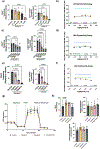Efficient megakaryopoiesis and platelet production require phospholipid remodeling and PUFA uptake through CD36
- PMID: 39195958
- PMCID: PMC11909960
- DOI: 10.1038/s44161-023-00305-y
Efficient megakaryopoiesis and platelet production require phospholipid remodeling and PUFA uptake through CD36
Abstract
Lipids contribute to hematopoiesis and membrane properties and dynamics; however, little is known about the role of lipids in megakaryopoiesis. Here we show that megakaryocyte progenitors, megakaryocytes and platelets present a unique lipidome progressively enriched in polyunsaturated fatty acid (PUFA)-containing phospholipids. In vitro, inhibition of both exogenous fatty acid functionalization and uptake as well as de novo lipogenesis impaired megakaryocyte differentiation and proplatelet production. In vivo, mice on a high saturated fatty acid diet had significantly lower platelet counts, which was prevented by eating a PUFA-enriched diet. Fatty acid uptake was largely dependent on CD36, and its deletion in mice resulted in low platelets. Moreover, patients with a CD36 loss-of-function mutation exhibited thrombocytopenia and increased bleeding. Our results suggest that fatty acid uptake and regulation is essential for megakaryocyte maturation and platelet production and that changes in dietary fatty acids may be a viable target to modulate platelet counts.
© 2023. The Author(s), under exclusive licence to Springer Nature Limited.
Conflict of interest statement
Competing interests
J.E.I. has financial interest in and is a founder of Stellular Bio, a biotechnology company focused on making donor-independent platelet-like cells for regenerative medicine. The interests of J.E.I. are managed by Boston Children’s Hospital. All other authors have no conflicts of interest to declare that are relevant to the content of this article.
Figures














References
MeSH terms
Substances
Grants and funding
- 5T32HL007734/U.S. Department of Health & Human Services | NIH | National Heart, Lung, and Blood Institute (NHLBI)
- Fellowship/Saudi Arabia Cultural Bureau in London (Royal Embassy of Saudi Arabia Cultural Bureau in London)
- R35HL161175/U.S. Department of Health & Human Services | NIH | National Heart, Lung, and Blood Institute (NHLBI)
- Senior award/Fonds de Recherche du Québec - Santé (Fonds de la recherche en sante du Quebec)
- R03DK124746/U.S. Department of Health & Human Services | NIH | National Institute of Diabetes and Digestive and Kidney Diseases (National Institute of Diabetes & Digestive & Kidney Diseases)
- R01DK112778/U.S. Department of Health & Human Services | NIH | National Institute of Diabetes and Digestive and Kidney Diseases (National Institute of Diabetes & Digestive & Kidney Diseases)
- R01HL151494/U.S. Department of Health & Human Services | NIH | National Heart, Lung, and Blood Institute (NHLBI)
- ASH Restart Award 2021/American Society of Hematology (ASH)
- 2009965/Department of Health | National Health and Medical Research Council (NHMRC)
- 23POST101143/American Heart Association (American Heart Association, Inc.)
- R01 HL151494/HL/NHLBI NIH HHS/United States
- 218649/Z/19/Z/Wellcome Trust (Wellcome)
- R01 DK139341/DK/NIDDK NIH HHS/United States
- DFG; BE 7766/2-1/Deutsche Forschungsgemeinschaft (German Research Foundation)
- R03 DK124746/DK/NIDDK NIH HHS/United States
LinkOut - more resources
Full Text Sources
Molecular Biology Databases
